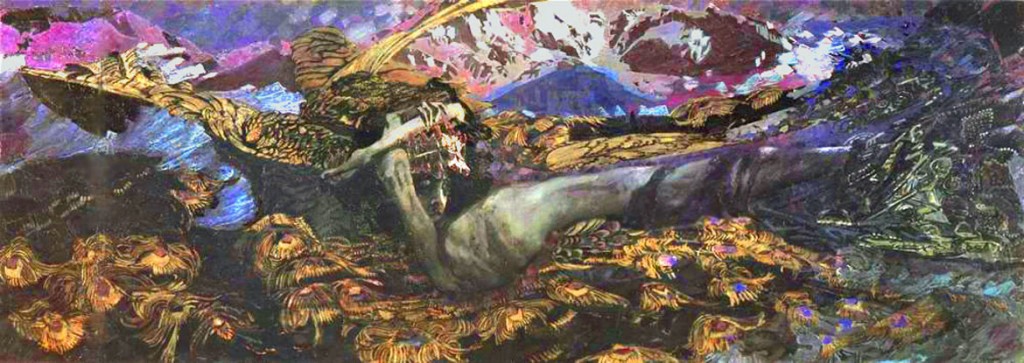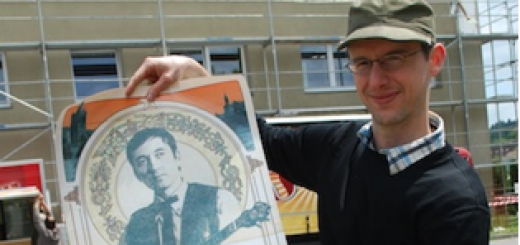A Conference Report on Scriabin Among the Symbolists: A Centennial Symposium at UCLA
Submitted by Monica Chieffo
This year marks the 100th anniversary of the death of Russian composer Aleksandr Scriabin, who, incidentally (mystical resonance?) died in Moscow at precisely this time of year during the Easter season of April 1915. Despite the composer’s intelligible Nietzschean personal beliefs (“I am God” served as the original last line of text for his 1908 large symphonic work, “Poem of Ecstasy”), historical attitudes toward Scriabin and his music abound with nebulous mystical and spiritual sentiments if not a tinge of collective skepticism toward the validity of his unique musico-religious worldview.
Obscuring the career and consummate influence of Aleksandr Scriabin are larger trends in the historical narrative of musical modernism, as noted by Richard Taruskin, to deliberately obfuscate mystical concerns. During his life, Scriabin enjoyed transatlantic fame for the musical sophistication and philosophical vision guiding his symphonic works. After a trip to America in 1906, the composer spent time in Paris where he, being a synesthete, discussed color and music with his friends Rachmaninoff and Rimsky-Korsakov. In fact, Scriabin imbued sonorities with extra-musical qualities, such as colors to key areas so as to indoctrinate his listeners in a multi-sensorial realm divorced from physical and logical reality. Moreover, his unique ideas on music found a kinship with the Theosophy of late nineteenth-century Russo-German occultist Helena Blavatsky. As a spiritual movement, Theosophy heralded the synthesis of science, religion and philosophy, which only further deepened Scriabin’s formalization of extra-musical ideas.
Couple this amalgam of influences and personalities with the pervasive goal toward indirect representation of the Ideal, eternal truth central to the Symbolist movement in poetry, visual art, and literature, and we stand on circumscribed, esoteric grounds. A write-up on Scriabin’s music just before his death touches on the opacity of Scriabin reception even today. One month before the composer’s death in 1915, the Musical Courier remarked, “It may be true that the Russian composer is too far advanced for the present generation and that his doctrine and music will be accepted in years to come.”
For comparison, let’s call to mind for a moment music that is likewise saturated with synesthetic and monumental commentary, and odiferous intertextuality. Like Scriabin, Debussy, in the French symbolist vein, evokes poetry, washes his listeners in sonic fragrances or flashes of light, with the ethos of fountains and fawns. While a figure like Mahler commands the respect of world-historical mourning, Scriabin continues to be mired in our listening and disciplinary writing by a facile engagement with seemingly incalculable solipsism and perhaps by our unease with mental illness—but even more so, by our [in]ability as academics to settle on the interminable state of multivalence, more generally. In short, the current reaction to Scriabin is complicated.
What’s more, if we expand further the implications of this knotty inheritance of both historical consciousness and analytical implication, we arrive still at another outlying micro-world: Russian musical modernism. Yet even so, the language of Scriabin’s music enjoins us to approach (and reproach) the composer as a symbol of universal late tonal extravagance. In its face, we teeter easily upon the opinion of effeteness, debasement, theatricality, and camp. You may have heard about Scriabin’s unfinished massive score for Mysterium, his pre-apocalyptic music, which he intended to be experienced at the foothills of the Himalayas with bells hanging from clouds. If Scriabin’s creative output, tendentious musical legacy, and thick artistic milieu seem to participate recalcitrantly with the so-called collective wisdom within musicology and elsewhere, then perhaps more private worship in the form of an intimate conference gathering can help provide revelations.
Last month, members of the UCLA Departments of Musicology and Slavic Languages and Literatures hosted a two-day conference entitled Scriabin Among the Symbolist: A Centennial Symposium. Those in attendance included scholars and performers from within the UCLA community, as well as the greater Southern California area with one scholar visiting from the UK. Paper presenters included Daniel Grimley (Oxford University), Klara Moricz (Amherst College), Jann Pasler (UCSD), Mitchell Morris, Ryan Rowen, Jeffrey Riggs (UCLA), Keenan Reesor (USC), Damjan Rakonjac (UC Riverside), with final reflections by Richard Taruskin (UC Berkeley). A soirée on Friday evening featured an array of symbolist visual art paired with performances of Russian poetry, song and piano music by Scriabin’s contemporaries, Nikolai Medtner, Sergei Taneyev, as well as Sergei Rachmaninoff and others. The evening drew participation from a host of talented performers. These included Russian poetry expert Ronald Vroon (UCLA), soprano Roksana Zeinapur (Cal Arts), baritone Vladimir Chernov, French poetry scholar Jean Claude Carron (UCLA), and pianists Ryan Rowen (UCLA) and Iris Hsu (Julliard/Peabody). The gathering was a special multi-media treat in true Symbolist fashion for everyone in attendance. As UCLA graduate student and pianist, Pheaross Graham commented, “Transitioning back to reality [after the soirée] took me some time…I was concerned whether it would be safe to drive back home as the music was that intoxicating.”
Professor Morris and Ryan Rowen deserve special congratulations and accolades for organizing the conference, soirée, and reception.
***
I attended most of the paper sessions on Friday afternoon as well as a few papers during the Saturday afternoon session. Having reflected on some of my overall impressions in light of my Scriabin centennial exposé above, here I report on a selection of papers, as well as major themes that emerged over the two-day conference. The papers shared a strong focus on historiography, musical and poetic analysis, hermeneutics, gender, and issues of performance. Collectively, they shed a new light on, and perhaps produced some transparency from within, Scriabin’s place in the “Silver Age” of cultural and artistic revival of early twentieth-century Russia, not to mention musical modernism, more broadly.
Mitchell Morris (UCLA) began the conference with a stimulating discussion of Scriabin through a kindred spirit, Chilean psychoanalyst Ignacio Matte Blanco (1908-1995). Morris applied Blanco’s concepts of “bilogic” and “trans-rational” in his analysis of Scriabin’s Piano Sonata No. 10 (1913). This conceptual framework brought to the fore the ways in which symmetrical chordal sonorities (i.e., dim. 7th, M7, Fr+6) translate into profoundly ambivalent phenomena. Morris’s analysis raised broader questions about how the often one-to-one relationships by which music theorists analyze and label musical syntax do not imply coherence of structure. For instance, an ad hoc analytical procedure responds more closely to musical ambivalence at hand, while it also engenders some latitude with labeling musical phenomenon as hexatonic poles. In the case of the Sonata No. 10 in C major, Morris questioned to what we actually listen by adopting a symbolist lens for analysis to fathom “epiphanies” in the sonic text. The call for an analytics that accounts for esthetic ambiguities was met with as much optimism as some skepticism. On the one hand, Symbolism provides an ulterior analytical framework comfortable with formal incoherencies. On the other, Richard Taruskin posed the question of what this kind of work would look like in practice and if music scholars might resolve not ambiguity, but rather assume multiple meanings in a single sonic phenomenon, pointing to the famous example of Wagner’s opening to Tristan und Isolde: a French augmented 6th chord that could (or rather is) also a major 7th.
The work of Keenan Reesor (USC) and Klara Moricz (Amherst College) touched on issues of musical representation through hermeneutical analysis. Reesor presented moderate revisionist project to Rachmaninoff scholarship with his paper, “The Blind Abyss: A Symbolist Reading of Rachmaninoff’s Francesca da Rimini.” Despite Rachmaninoff having been rejected by Scriabin disciples for his comparatively anti-modernist stance, Reesor provided a thoughtful response to entrenched generalizations by scholars, such as Simon Morrison, about Rachmaninoff’s music that consequently presume meaning afforded by the composer’s staunchly Romantic take on composition. As a result, scholars overlook the possibility of symbolism as an organizing concept in his music. In his 1905 opera, Francesca, based on Dante’s Inferno, Rachmaninoff tends to favor musical progressions that complicate linear temporal narrative while at the same time communicate very gradual emotional states over a series of explicit dramatic events. In this way, Reesor argues for an acknowledgement of the opera’s kinship with symbolism. By way of conclusion, he compares Rachmaninoff’s manipulation of musical language, fragmentation, and collapsed temporality between past, present, and future to the visual work of Russian painter Mikhail Vrubel.
Klara Moricz discussed intertextuality in music once-removed from that of Scriabin, either forward or backward in time. In her paper, “Skryabin’s Erotic Sublime and the Carnal Temptations of the Jewish Orient: Alexander Krein’s Sonata for Piano, op. 34,” Moricz explores themes of musical difference in the form of gendered and Jewish exoticism in the music of Russian-Jewish composer Alexander Krein, who, as she informs us, has no entry today in the New Grove Dictionary of Music and Musicians. In her comparative analysis of Liszt’s piano sonata in B minor and Krein’s op. 34 in the same key, Moricz revealed the ways in which mysticism informed the musical form with a brand of androgynist racialism. As Moritz argued, Krein’s sonata figures against the more Western masculine intentionality of Scriabin’s musical logic. The dominant cadential phrases in Liszt’s sonata, for instance, evince a masculinized Western language in contrast to the Klezmer-influenced “Jewish melos” that Krein deployed. The Q&A discussion touched on Scriabin’s complex gender presentation as well as the political implications of Krein’s own identity, as an ancient pre-individualistic Jewish mythology pitted against Scriabin’s highly individualistic persona(e).
Ryan Rowen’s paper on Saturday afternoon drew our attention toward performance as an act of ekphrasis and, as he commented, to “deliberately imagine beyond what is already there” in exploration of the synesthetic imagination. Drawing on his own experience performing Scriabin’s music along with a video recording of Vladimir Horowitz’s rendition of Vers la flamme (1989?), Rowan employed an experiential analytical model to come to terms with the difficulties of understanding Scriabin’s piece as dense with symbols of literal and metaphorical self-destructive “fires.” He also posed questions about how the performer must physically interface with Scriabin’s music to produce the sonic text. That is, the music is damn hard to execute. Echoing a point made earlier by Keenan Reesor, might symbolism (rather than semiotics or music theory) better serve as a point of critical inquiry on both analytical and performative fronts? Put another way, how can music cause an apocalyptic change? At the time, I suspected that such change ultimately hinges on the internal and self-interested intentions of the performer.
The collective proceedings of Scriabin Among the Symbolists makes the case, I think, for a renewed and more serious critical interest in Scriabin as well as in projects that reassess how we perform, analyze and discuss “difficult” musics. During one of the Q&A sessions in which some attendees expressed sympathy for the category of the ineffable in Scriabin’s music, Richard Taruskin quickly remarked that musicologists are, after all, “in the business of talking.”
***
Monica Chieffo is a PhD student in the Department of Musicology at UCLA with research interests in the performance and material history of opera in the seventeenth, eighteenth, and early twentieth centuries, the ethics of sound and aurality, and practices of listening as they related to music and philosophy. At UCLA, Monica is pursuing a Graduate Certificate in the Experimental Critical Theory program. As a harpist, she performs repertoires from early modern to contemporary and performs with the UCLA Early Music Ensemble.
Patrick Bonczyk, Blog Editor and PhD student at UCLA Musicology, edited this blog post. The EchoBlog is a space where scholars can engage informally with topics of interest in the form of thought pieces, interviews, concert reviews, and more. Please contact Patrick Bonczyk at echojour@humnet.ucla.edu with potential post ideas an submissions.




